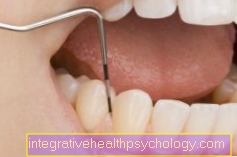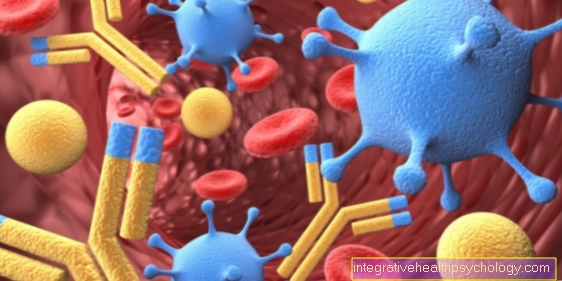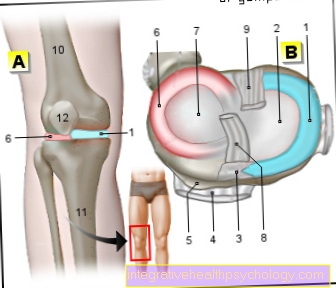Nasal spray
introduction
Nasal sprays belong to the group of so-called aerosols, i.e. mixtures of liquid components and gas. Through the spray system, the liquid active ingredients are finely distributed in the air and can be inhaled (inhaled) become. In principle, a distinction is made between locally acting and systemically acting nasal sprays. As a rule, however, the term 'nasal spray' means the first variant.
Hygiene must generally be a top priority when using nasal sprays! The applicator should be cleaned after each use in order to prevent colonization with bacteria and germs. In addition, the nasal spray should only be used by one person at a time. In order to achieve the exact dosage per spray, it is advisable to fill the spray head for the first time by pumping it several times and to actuate the first spray outside of the nose.

Local nasal sprays
Decongestant nasal spray
Runny nose, e.g. as part of an inflammation of the nasal mucous membrane (Rhinitis), Colds with inflammation of the sinuses (Sinusitis) or infections of the ear trumpet (Tubular middle ear catarrh) may require treatment with a decongestant nasal spray. With the mentioned clinical pictures, the mucous membrane of the nose swells. As a result, the increased secretion can no longer flow away and the sinuses are no longer adequately ventilated. This creates an excellent breeding ground for numerous germs.
To prevent this, the decongestant nasal sprays act as so-called sympathomimetics. Simply imagine that the active ingredients are the natural messenger substances (Transmitter) of the body, in this case adrenaline and noradrenaline. The nasal mucous membrane reacts locally by activating the sympathetic nervous system via special sensors (alpha receptors) that are sensitive to adrenaline and northern adrenaline or the active ingredients of the nasal spray.
In response, the blood vessels in the nasal mucosa constrict, causing it to swell. The secretion flows off and the sinuses are adequately ventilated again. The active ingredients of decongestant nasal sprays include xylometazoline hydrochloride, oxymetazoline, tramazoline, naphazoline and tetryzoline.
The duration of application must not exceed a period of about 5 days, otherwise a massive habituation effect sets in. In the worst case, even a "nasal spray addiction" arises! If you use the spray for too long, the nasal mucous membrane reacts by increasing the formation of alpha receptors. The original dosage quickly becomes insufficient, and more nasal spray must be used to achieve the same effect. Ultimately, just omitting the spray causes the mucous membrane to react with reactive swelling, so that free breathing through the nose is no longer possible.
Read more about here Dependence on nasal spray.
Although the drug is available from pharmacies without a prescription, the following people are generally not allowed to use decongestant nasal spray:
- People with dry inflammation of the nasal mucosa and crust formation (Rhinitis sicca)
- People who have surgery to remove the pineal gland through the nose (transsphenoidal hypophysectomy) or other operations after which the meninges are exposed
- Infants and young children
Particular caution is required with:
- increased pressure in the eye (narrow-angle glaucoma)
- pregnancy
- severe cardiovascular disease and high blood pressure (hypertension)
- certain metabolic disorders (e.g. hyperthyroidism, diabetes mellitus)
- simultaneous use of monooxidase inhibitors (MAO inhibitors) to increase blood pressure
- Prostate enlargement
- Adrenal cortex tumor (Pheochromocytoma)
- Porphyrias (group of metabolic diseases).
Active ingredients and their additives differ depending on the manufacturer. Some preparations are given below as examples:
- Nasal spray ratiopharm® adults, 0.1% xylometazoline hydrochloride
- Olynth Nasenspray®, 0.1% xylometazoline hydrochloride
- Imidin N Nasenspray®, 0.1% xylometazoline hydrochloride.
- Nasic®
- Nasic® nasal spray for children
Sea water nasal spray
Seawater nasal spray consists of so-called isotonic saline solution, i.e. the salt content of the spray (0.9% sodium chloride) corresponds to the salt content of human cells. First and foremost, it moisturizes the nasal mucous membrane and, by liquefying the nasal mucus, has a cleansing or rinsing effect. In dry room air, especially in the cold winter months, the spray can have a caring effect on the nasal mucosa. In addition, the treatment can painlessly loosen hard crusts, so-called crusts.
The use of sea water nasal spray has no decongestant effect in the actual sense, but is perceived as pleasant and well-being in the accompanying treatment of colds. It can be used over a longer period of time without hesitation, as no habituation or even 'dependency' effect is to be expected.
Pregnant women and young children are also safe to use seawater nasal spray. Since it does not belong to the group of medicinal products, it is freely available in drug stores or supermarkets. When buying, you should make sure that the product is free from preservatives.
Antihistamine nasal spray
Antihistamine nasal spray has antiallergic properties. It is suitable for treating hay fever (seasonal allergic rhinitis) and is available from pharmacies without a prescription. The most common active ingredients include levocabastine and azelastine.
In the human body, the messenger substance histamine mediates allergic reactions. The nasal spray now blocks the effect of histamine, so that an allergic reaction is prevented from developing. The complaints, such as Itching and tingling of the nose are relieved. Since the drug is only used locally, it is not associated with the usual side effects of antiallergic agents, e.g. Expect tiredness.
Instead, patients often report a bitter taste in the mouth, occasionally the nasal lining may become irritated and nosebleeds may occur from nasal spray. In very rare cases, hypersensitivity reactions have been observed. Pregnant women should not use antihistamines nasal spray in the first three months of pregnancy; during breastfeeding, treatment should only be carried out in consultation with a doctor.
Examples of preparations are given below:
- Livocab direct nasal spray®
Active ingredient: levocabastine - Vividrin akut®
Active ingredient: azelastine.
Learn more about: Nasal spray for an allergy
Livocab®
Livocab® is a nasal spray that is based on the active ingredient levocabastine. The nasal spray is used to treat the symptoms of allergic rhinitis (hay fever). It has antihistamine, antiallergic and anti-inflammatory effects. Levocabastine belongs to the group of H1 blockers. It prevents the body's own messenger substance histamine from binding to this receptor. This leads to a reduction in allergy symptoms.
Like the active ingredient azelastine hydrochloride in the Vividrin® nasal spray, levocabastine in the Livocab is a second-generation H1 blocker and therefore only rarely leads to central nervous symptoms such as fatigue. Possible side effects are local reactions and hypersensitivity reactions in and on the nose, as well as headaches. Livocab® is approved for children from one year. It is used twice a day with 2 sprays per nose. The nasal spray can be used for the entire period of the allergen (e.g. pollen). The attending physician should be asked about the use during pregnancy, breastfeeding and in combination with other medications.
Read more on the topic: Livocab® nasal spray
Vividrin®
Vividrin® nasal spray is an antiallergic or antihistamine. It is primarily used in the area of seasonal allergic rhinitis (hay fever). The medicinal ingredient is azelastine hydrochloride. This substance acts as a blocker on the H1 receptor and thereby prevents the body's own messenger substance histamine from binding. This will reduce the occurrence of allergy symptoms. Vividrin belongs to the group of H1-Blcokers of the second generation. This means that they are a further development of an original active ingredient.
The advantage of this second generation is that they do not cross the blood-brain barrier and cause no or less central nervous symptoms (fatigue). Vividrin is approved for children 6 years and older, adolescents and adults. The recommended application is one spray per nostril twice a day. The nasal spray can be used permanently. However, this should be done in consultation with a doctor. During pregnancy and breastfeeding, Vividrin should not be used or only after consultation with a specialist. An overdose is unlikely as Vividrin only acts locally in the nose. However, it can potentially e.g. swallowing the contents causes tiredness, drowsiness or restlessness. A doctor should be called in here urgently. In Germany there is also a second nasal spray that uses the active ingredient azelastine: Allergodil
Olynth®
Behind the product name Olynth® there are several products in the field of nasal drops and nasal sprays. The nasal sprays with the name Olynth are based on the active ingredient xylometazoline hydrochloride. The nasal sprays are available in two concentrations. In 0.1% solution for children and adolescents over 6 years of age and adults. For children between 2 and 6 years of age, Olynth is available in a solution concentration of 0.05%. As an additional product there is Olynth Ectomed nasal spray on a natural basis; the active ingredient ectoin is used. This binds water and creates a watery film on the nasal mucosa that is supposed to have a protective effect.
The areas of application of Olynth nasal spray based on xylometazoline hydrochloride are rhinitis (to reduce the swelling of the irritated nasal mucosa), allergic rhinitis (allergic rhinitis) and so-called rhinitis vasomotorica. In addition, Olynth can be used for sinus infections and otitis media. The dosage for children over 6 years and adults is up to 3 times a day one spray per nose.
For children between 2 and 6 years of age, the dosage is the same, except that the solution with a 0.05% concentration of the active ingredient is used. Children under 2 years of age should not receive the nasal spray in either concentration. It should not be used for more than a week, as long-term use can damage the nasal mucosa. Olynth nasal spray should not get into the reach of children. A variety of symptoms can occur with overdose (e.g.Changes in body temperature, pupils, circulatory status, heartbeat and also mental health). A doctor should be consulted urgently.
Read more on the topic. Olynth®
Otriven®
Like the Olynth® product, the nasal spray is based on the active ingredient xylometazoline hydrochloride. The active ingredient is contained in a concentration of 0.1%. The effect is based on the vasoconstricting effects, which lead to a decongestion of the mucous membrane. Otriven is used for swelling of the nasal mucous membrane, colds, runny nose (rhinitis vasomotorica), allergic rhinitis (e.g. hay fever) and also for middle ear and sinus infections.
It can be used in adolescents and adults over 12 years of age. The recommended daily dose is one spray per nostril three times a day. A higher dose or use of Otriven® for more than a week is not recommended due to the potential for damage to the nasal mucosa. Use during pregnancy and breastfeeding should be discussed with a doctor or pharmacist. The use of Otriven nasal spray in the case of a bumpy inflammation of the nose (rhinits sicca), after a pineal gland removal and an existing glaucoma must not be used, unless it has been agreed with the treating doctor.
Nasic®
The Nasic® nasal spray is used to decongest the nasal mucosa in the event of a cold, to support the healing of minor injuries to the nasal mucous membrane, in rhinitis vasomotorica, and to support nasal breathing after operations in the nasopharynx. The active ingredients contained are dexpanthenol 5% (wound healing and mucous membrane protection) and xylometazoline hydrochloride 0.1% (decongestion due to vasoconstriction).
For more information, see: Nasic®
Nasic must not be used in this concentration in children under 6 years of age, in patients with crust formation in the nose (rhinits sicca) and after surgery on the pineal gland. The dosage for children from 6 years of age and adults is one spray per nostril up to three times a day. Nasic nasal sprays with a lower concentration of active ingredient (0.05%) are available for children between 2 and 6 years of age.
Also read the article on the topic: Nasic® nasal spray for children
Higher doses and overdoses should be avoided, especially in younger children. Regular use should be limited to one week, as longer applications can damage the nasal mucosa. Patients who are pregnant, breastfeeding or with glaucoma should discuss the use of Nasic nasal spray with their doctor beforehand.
Glucocorticoid nasal spray
Glucocorticoid nasal spray, also popularly known as "cortisone nasal spray", has an anti-allergic and anti-inflammatory effect on the nasal mucous membrane. The treatment can alleviate symptoms for allergic hay fever, but also for colds caused by cold.
In contrast to antihistamine nasal sprays, cortisone products have to be used longer, but the effect achieved is stronger.
With long-term treatment, side effects that affect the whole body (systemic side effects) may occur.
These include Cushing's syndrome (full moon face, bull's neck, facial flushing), adrenal disorders, growth retardation in children and adolescents, clouded lenses or increased intraocular pressure (glaucoma).
In rare cases psychological changes have been observed. Long-term treatment should therefore only be carried out with the consent of the doctor!
For over-the-counter self-medication for hay fever, sprays with the active ingredient beclometasone are available in pharmacies.
Nasonex®
Nasonex® is a nasal spray based on the active ingredient mometasone furoate. This is an active ingredient that belongs to the group of corticoid steroids. Nasonex is mainly used for allergic rhinitis and nasal polyps. In the area of application of allergic rhinitis, there is, on the one hand, seasonal use in the case of seasonal allergic rhinitis (hay fever). There is an allergic reaction to seasonal pollen and spores. On the other hand, Nasonex can be used against perennial rhinits (year-round cold); there are reactions to various factors, e.g. House dust or mites.
For people over 12 years of age, it should be used once a day with two sprays per nostril. Children between 3 and 11 years of age should only use one puff per nostril. In addition to allergic rhinitis, a focus of the application is the presence of nasal polyps. The small growths of the nasal mucous membrane can reduce the inflammation of the nasal mucous membrane to relieve symptoms. For 5 to 6 weeks, people over the age of 18 can work once a day with two sprays per nostril.
If there is no improvement, the prescribing doctor may recommend increasing the dose. During pregnancy and lactation, Nasonex should only be used after consulting a doctor or pharmacist. If there is an allergy to the active ingredient or if further medication is taken, the application should only be carried out after consultation with the treating doctor. Swelling in the face and mouth as well as swallowing difficulties, breathing difficulties and rashes can occur as undesirable side effects.
Read more on the topic: Nasonex®
Systemic nasal sprays
Systemic nasal sprays do not develop their effect locally in the nose, but work throughout the body. The nasal mucous membrane is very well supplied with blood, and is therefore ideally suited for taking (Absorption) certain active ingredients into the body's circulation. So e.g. In contrast to oral administration, the gastrointestinal tract is bypassed and the desired effect can set in more quickly.
The two most common systemic nasal sprays include:
Fetanyl nasal spray
Fetanyl nasal spray is one of the so-called opioids ('opiates') and falls under the Narcotics Act. It is used for severe episodes of pain in the context of tumor diseases. The great advantage of the nasal spray is the very fast action time of around 10 minutes. Comparable opioids, e.g. Taken as a tablet, strike much later.
Desmopressin nasal spray
In certain clinical pictures, such as the central diabetes insipidus, lies a disorder of the formation of antidiuretic hormone, ADH for short (also called vasopressin). As a result, the body sheds each day up to 25 liters Urine from (Polyuria) and arises great thirst (Polydipsia). Synthetically produced Desmopressin, is similar to the body's own hormone ADH and can thus imitate its effects.
Until 2007, the nasal spray was also available as a Therapy for bedwetting children at night authorized. However, due to dangerous side effects, it is allowed for these purposes only in tablet form be applied.





























